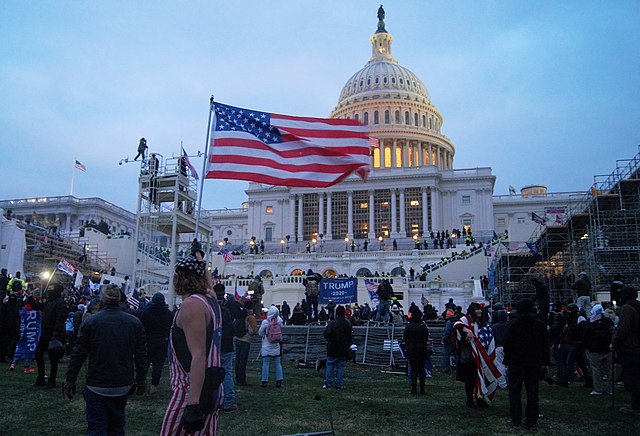Architectural propaganda
건축 선전이란 선전의 목적으로 건축을 사용하는 것을 말한다. 역사적으로, 중요한 건축물들은 사상을 전달하기 위해 사용되어 왔으며, 그 중에는 존경과 복종을 얻으려는 의도를 담은 건축물들도 많다.
Architectural propaganda is the use of architecture for the purpose of propaganda. Throughout history, significant architectural works have been used to convey ideas, including many intended to command respect and obedience.
예시
Examples
중국
China

중국(중화인민공화국; PRC)은 현재 다른 많은 국가, 특히 개발도상국을 대상으로 장기간에 걸친 홍보 캠페인을 벌이고 있다. 이 캠페인을 조슈아 컬란치크(1976~)은 자신의 동명의 책에서 “참 오펜시브(매력 공세)”로 명명했다. PRC가 사용하는 소프트 파워의 여러 요소들 중에는 건축도 포함된다. 중국은 풍부한 건축 전통을 바탕으로 이를 홍보할 수 있다. 이를 통해 중국 정부는 만리장성이나 자금성 같은 유명한 건축 유적에 대한 관광을 홍보할 수 있다. 뿐만 아니라, 풍부한 건축 역사와 친중국 정서를 확산시키려는 열망이 결합되어 해외 프로젝트에 대한 중국의 자금 지원이 점점 더 보편화되고 있다. “… 많은 학자들은 중국의 원조를 대형 건물과 부처 그리고 유사한 건설물 같은 거대한 흰 코끼리 프로젝트와 연관시킨다.”
The People’s Republic of China (PRC) is currently engaged in a prolonged public relations campaign with many other nations, the developing world particularly. This campaign has been termed a “charm offensive” by Joshua Kurlantzick in his book of the same name. Among the many elements of soft power used by the PRC is that of architecture. China has a rich architectural tradition to draw from and to publicize with. This allows the PRC government to promote tourism to famous architectural sites like the Great Wall or the Forbidden City. Furthermore, a rich architectural history combined with a desire to spread pro-PRC sentiment means that PRC funding of building projects abroad is increasingly common. “. . . Many scholars associated China’s aid with giant white-elephant projects, like large buildings and ministries and similar structures.”
과거 포르투갈 식민지였던 모잠비크의 수도 마푸토에는 포르투갈-스타일 건축양식이 대부분인 외무부 건물이 있으며, 역시 과거 포르투갈 식민지였던 동티모르에서는 양측의 오랜 적대관계에도 불구하고 중국이 동티모르 외무부 건설에 자금을 지원하고 홍보했으며 베이징에 새로운 동티모르 대사관을 설립하는 데 자금을 지원했다.
In Mozambique, a former Portuguese colony possessed of largely Portuguese-style architecture, in the capital city, Maputo, the Ministry of Foreign Affairs building In East Timor, also a former Portuguese colony, the PRC funded and promoted the construction of that country’s foreign ministry and funded the creation of a new East Timor embassy in Beijing despite the long-standing antagonism between the two parties.
중국의 관광산업을 활성화하기 위한 건축의 활용은 매우 성공적이었다. 2015년 현재, 중국은 프랑스, 미국, 스페인에 이어 세계에서 네 번째로 관광객이 많은 국가로, 연간 5,690만 명의 해외 관광객이 방문하고 있다. 2010년 중국의 외환 수입은 458억 달러로 세계에서 네 번째로 큰 규모였다. 국내 관광객 수는 총 16억 1천만 명, 총 수입은 7,771억 위안에 달했다. 확실히 이 모든 관광이 건축에만 기인한다고 볼 수는 없지만, 방문한 관광지 중 상당수는 고유한 건축적 가치를 지니고 있다.
The use of architecture to fuel tourism in the PRC has been highly successful. As of 2015, China is the fourth most visited country in the world, after France, United States, and Spain, with 56.9 million international tourists per year. Foreign exchange income was 45.8 billion U.S. dollars, the world’s fourth largest in 2010. The number of domestic tourist visits totaled 1.61 billion, with a total income of 777.1 billion yuan. While certainly all of this tourism cannot be attributed to architecture alone, a significant number of the tourist sites visited possess inherent architectural value.
멕시코 마약 카르텔
Mexican drug cartels
멕시코 마약 카르텔은 그들의 전반적인 선전 캠페인의 일환으로 건축을 활용했다. “나르코 맨션 또는 나르코 카스티요(마약 저택 또는 성)”라고 불리는 대형 주택은 최근 멕시코의 마약 분쟁에서 점점 더 흔히 볼 수 있는 특징이 되고 있다. 이러한 부와 권력의 과시는 적어도 부분적으로 심리적 가치를 위해 지역 주민들과 잠재적 경쟁자를 압도하고 지배하기 위해 지어진다.
Mexican drug cartels have utilized architecture as part of their overall propaganda campaign. Large houses called “narco mansions or narco castillos (drug mansions or castles)” are becoming an increasingly common feature of the recent drug conflicts in Mexico. In order to overwhelm and sway over local populaces and potential rivals, these demonstrations of wealth and power are built at least partly for their psychological value.
나치 독일
Nazi Germany
나치 건축은 고대 로마에 대한 아돌프 히틀러의 개인적인 매혹에 따라 신고전주의 양식과 아르데코 양식의 많은 요소를 채택했다. 나치 컬트(추종; 숭배)의 일부는 개인을 더 큰 독일 민족으로 압도하고 포섭하는 것과 관련이 있다. 이렇게 자기 자신을 전체에 넘겨주는 것은 나치 건축을 통해서도 표현되었다. 나치 건축에서 표현된 세 가지 주요 역할은 (i)연극적, (ii)상징적, (iii)교훈적이지만, 이러한 역할들 각각은 선전 가치의 더 큰 영역 내에서 자신의 위치를 차지한다.
Nazi architecture adopted many elements of neoclassicism and of art deco in keeping with Adolf Hitler’s personal fascination with Ancient Rome. Part of the Nazi cult involved the overaweing and subsuming of the individual into the greater German volk. This giving over of oneself to the whole was also expressed through Nazi architecture. The three primary expressed roles found in Nazi architecture are the (i)Theatrical, (ii)Symbolic, and (iii)Didactic, but each of these roles has its own place within the larger sphere of propaganda value.

나치 건축은 높은 천장의 사용하여 개인이 작고 하찮은 느낌을 주도록 디자인되었다. 예를 들어, 뉘른베르크 집회에서 체펠린트리뷴 건축물의 구조와 함께 군중이 모여서 만들어내는 느낌은 경이로움과 강력한 공동체 의식을 불러일으켰다. 실제로, 히틀러는 뉘른베르크 집회 연설에서 “여러분 모두가 나를 보는 것은 아니며, 나도 여러분 모두를 보지 못합니다. 하지만 나는 여러분을 느끼고, 여러분은 나를 느낍니다!”라고 말했다. 뉘른베르크 집회에서, 나치의 세계관을 더욱더 믿도록 유도하는 “빛의 대성당”을 만들기 위해 위를 향하는 탐조등(써치라이트)을 많이 사용하여 건축의 전반적인 효과를 더욱 강화했다.
Nazi architecture was designed to make the individual feel small and insignificant through its use of high ceilings. For example, at Nuremberg rallies, the feeling produced by the use of massed groups coupled with the architecture of the Zepplintribune architecture was to create wonder and a powerful feeling of community. Indeed, Hitler stated in one of his Nuremberg rally speeches, “Not every one of you sees me and I do not see every one of you. But I feel you and you feel me!”. At the Nuremberg rallies, the overall effect of architecture was further enhanced through the use of many searchlights pointed directly upward in order to create a “Cathedral of Light” that even further served to invite the individual to buy into the Nazi worldview.
나치 건축의 또 다른 두드러진 개념적 특징은 히틀러의 개인 건축가인 알베르트 슈페어(1905~1981)가 처음 제시한 “폐허 가치 이론”이었다. 이 이론은 한 문명의 영향력이 문명 자체의 존재를 넘어서기 위해서는 그 문명의 낡은 건물이 미학적으로 아름답고 인상적인 폐허를 남기는 것이 중요하다고 가정했다. 이 이론 역시 고대 로마와 그리스로부터 영감을 받아 수천 년 지난 나치 문명의 건축 유적으로 모방하려고 시도한 것이다. 나치 건축의 원조가 고대 로마 양식과 그리스 양식이었기 때문에, 히틀러는 천년 제국 말기에 로마 유적이 그랬던 것처럼 유적이 다른 이들에게 영감을 줄 수 있다는 점을 중요하게 생각했다.
Another prominent conceptual feature of Nazi architecture was the “Theory of Ruin Value”, first put forward by Albert Speer, Hitler’s personal architect. This theory postulated that in order for a civilization’s influence to pass beyond the existence of the civilization itself, it was important that aesthetically pleasing and impressive ruins be left by the dilapidated buildings of that civilization. This theory, too, took inspiration from the ancient Romans and Greeks in attempting to emulate the even architectural remains of their civilizations with Nazi ones in thousands of years. Since the original inspiration for Nazi architecture was itself, the ancient Romans and Greeks, it was important to Hitler that at the end of the Thousand Year Reich, the remains would inspire others as Roman ruins had done for him.
2008년에 모든 공항 운영을 중단한 베를린 템펠호프 공항에는 흥미로운 나치 건축물의 잔재가 남아 있다. 이 메인 터미널은 에른스트 자게비엘(1892~1970)의 디자인으로 슈페어와 히틀러의 사상에 따라 1930년대 말과 1940년대 초 디자인 및 건설되었다. 그것은 (게르마니아라고 불리게 될) 히틀러의 재설계된 베를린을 위한 주요 허브가 되도록 디자인되었다. 완공 당시에는 세계에서 가장 큰 건물이었으며, 오늘날 이 건물이 파손되면 슈페어와 히틀러의 폐허 가치 이론이 입증될 수 있다.
An interesting remaining piece of Nazi architecture can be found in the former Berlin Tempelhof Airport which closed all airport operations in 2008. The main terminal was designed and built during the late 1930s and early 1940s according to a design by Ernst Sagebiel following the ideas of Speer and Hitler including that of ruin value. It was designed to be the main hub for Hitler’s redesigned Berlin, to be called Germania. When completed, it was the world’s largest building and today, should the building fall into disrepair, Speer and Hitler’s ruin value theory may be demonstrated.
북한
North Korea
미국 건축가 리처드 부데이는 번영하는 북한의 이미지를 전달하고 남한 군인들의 귀순을 장려하기 위해 건설된 기정동의 포템킨 마을을 건축 선전의 예시로 언급했다.
The Potemkin village of Kijŏng-dong, which was constructed to convey an image of North Korea as prosperity, and to encourage South Korean soldiers to defect, has been cited as an example of architectural propaganda by architect Richard Buday.
미국
United States
건축 선전은 미국 역사를 통해 꾸준히 사용되어 왔다. 독립 국가로서 초창기에는 신고전주의 건축 양식이 민주주의, 안정, 세련됨을 나타내기 위해 자주 활용되었다.
Architectural propaganda has been used throughout the history of the United States. Early in its history as an independent country, neoclassical architecture was often employed to convey allusions to democracy, stability, and refinement.
뉴딜 정책 기간 동안, 현대적이고 진보적인 이미지를 전달하기 위한 노력으로 많은 정부 건물들이 아르데코 양식으로 건설되었다.
During the New Deal, many government buildings were constructed in an Art Deco style in an effort to convey a modern and progressive image.
모더니즘 건축은 냉전 시대 동안 미국에서 보편화되었으며, 효율성 및 기술적 우월성 같은 이념을 드러내는 데 사용되었다.
Modernist architecture became common in the United States during the time of the Cold War, and was used to demonstrate ideas such as efficiency and technological superiority.
21세기 들어서 미국 내 정치적 우파 인사들은 신고전주의 건축 양식의 사용을 장려해 왔다. 아메리카 퍼스트 코커스를 위한 제안에서는 “세계 강국이자 자유의 원천에 걸맞는” “유럽 건축”을 지지한다고 밝혔으며, 당시 대통령이었던 도널드 트럼프는 정부 건물에 신고전주의 건축 양식을 의무화하는 행정 명령1을 통과시켰고, 기존의 모더니즘 연방 건물들을 철거하거나 리모델링할 것을 권고했다. 트럼프의 행정 명령은 후임 대통령인 조 바이든에 의해 빠르게 번복되었고, 비-고전주의 건축을 막거나 금지하려는 요구는 건축가 단체들과 건축 회사들의 반발을 샀다. 일부 사람들은 또한 이 시기에 미국에서 고전주의 건축 부활에 대한 관심이 증가한 것을 백인 민족주의와 연관짓기도 한다.
During the 21st century, figures on the political right-wing in the United States have promoted the use of neoclassical architecture. Proposals for an America First Caucus have endorsed “European architecture” as “befitting a world power and source of freedom”, and then-President Donald Trump passed an executive order mandating the use of neoclassical architecture in government buildings, and recommended demolishing or re-modeling existing modernist federal buildings. Trump’s executive order was quickly overruled by subsequent President Joe Biden, and calls to discourage or prohibit non-classical architecture have been opposed by groups representing architects, and architectural firms. Some have also linked the uptick in interest in reviving classical architecture in the United States during this time with white nationalism.

- 출처 : 「Architectural propaganda」, Wikipedia(en), 2022.10.26.
- 업데이트 : 2025.3.11.
- 아름다운 연방 시민 건축을 촉진하는 행정 명령, (2020.12.21). 2025년 1월 20일, 다시 대통령이 된 도널드 트럼프가 정부 건물에 ‘고전적’ 건축을 의무화하는 행정 명령 재도입했다. ↩︎